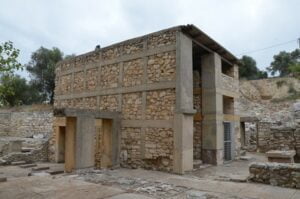
North Lustral Basin: Restoring the Palace at Knossos and Uncovering its Mysterious Subterranean Structures
The Palace at Knossos is a marvel of the ancient world. Built on the island of Crete around 1700 BCE, this impressive structure was home to several generations of Minoan kings.
However, the palace fell into disrepair and was abandoned for thousands of years. In the early 1900s, archaeologists began the painstaking process of restoring the Palace to its former glory.
While the restoration process has uncovered many mysteries about the Minoan civilization, ongoing efforts are still needed to uncover the secrets of Knossos.
One of the most important restoration projects at Knossos is the North Lustral Basin. This area suffered damage over time, and restoration efforts aim to repair this damage and preserve the area for future generations. In this article, we’ll explore the restoration efforts at the Palace at Knossos and uncover the mysteries of the subterranean structures.
Table of Contents
The Purpose of Subterranean Structures in Minoan Palaces and Villas
During the Minoan period, many palaces and villas featured subterranean structures. Archaeologists have proposed several theories about the purpose of these structures, including storage, workshops, or even hiding places during times of war. However, many experts agree that the subterranean areas of Minoan palaces and villas were primarily used for purification ceremonies.
The symbolic significance of purification ceremonies cannot be underestimated. The Minoans believed that the purity of a person’s soul was essential for a good life, and cleansing the body through water was a vital part of these purification rituals. Several subterranean chambers at Knossos, such as the North Lustral Basin, were used for these ceremonies.
Uncovering the Lid of an Alabaster Bowl with the Cartouche of Khyan
During the restoration of the North Lustral Basin, archaeologists discovered a rare treasure – an alabaster bowl with the name of Hyksos king Khyan inscribed on the lid. The Hyksos Dynasty was a foreign dynasty that ruled over parts of ancient Egypt during the Second Intermediate Period. This discovery challenged long-held beliefs about the isolation of Minoan society from the rest of the Mediterranean world.
The discovery of this rare artifact has opened up new avenues for research into Minoan trade and relations with other Mediterranean civilizations. The lid is thought to have been a diplomatic gift that was brought to Knossos from the Hyksos capital of Avaris.
Restoration Efforts at the Knossos Archaeological Site
Preserving historical sites like Knossos is vital for future generations to learn about the past. Restoration work at Knossos has been ongoing since the early 1900s, and the North Lustral Basin is just one example of the work being done to preserve these ancient structures.
Restoration at Knossos involves a combination of scientific research, artistic interpretation, and careful conservation. Using the latest techniques, archaeologists can reconstruct the palace’s walls, frescoes, and other decorative elements with incredible accuracy. The goal is to restore Knossos to its former glory while maintaining the integrity and authenticity of the site.
In conclusion, the Palace at Knossos is a priceless archaeological treasure that has revealed much about the Minoan civilization. Restoration efforts are ongoing, and discoveries like the lid of the alabaster bowl with the cartouche of Khyan continue to shed light on this ancient culture. By preserving these structures, we can learn more about the Minoans and their impact on the greater Mediterranean world. So, next time you visit the Palace at Knossos, take a moment to appreciate the efforts that have gone into restoring this ancient marvel.
Sources – Further Research
- McEnrone, J. (2010). Architecture of Minoan Crete. University of Texas Press.
- Jarus, O. (2017). Knossos: Palace of the Minoans. https://www.livescience.com/27955-knossos-palace-of-the-minoans.html
- German, S. (2020). Knossos. https://www.khanacademy.org/humanities/ancient-art-civilizations/aegean-art1/minoan/a/knossos
- Ephorate of Antiquities of Heraklion – Knossos Scientific Committee. (2015). Knossos Documenta. https://knossosdocumenta.gr/en/the-palace-of-knossos/
- Gibson, G., Morden, M., Rowbotham, W. (2017). Odyssey Adventures in Archeology. https://www.odysseyadventures.ca/articles/knossos/articleKnossos03.approach.html










